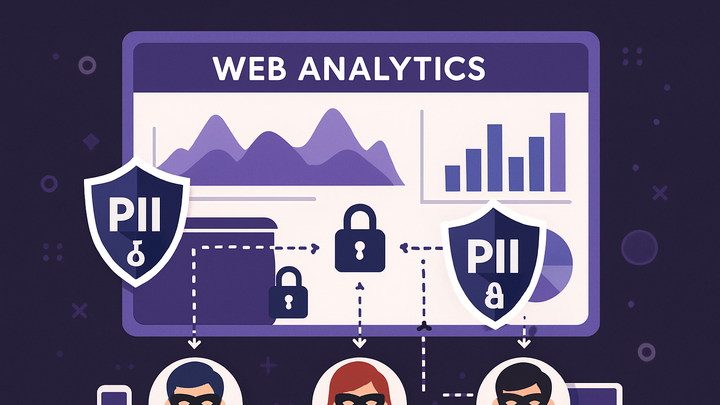Published on 2025-06-22T04:25:11Z
What is PII (Personally Identifiable Information)? Examples for PII in Analytics
PII (Personally Identifiable Information) in web analytics refers to any data that can be used to identify an individual, either directly or in combination with other data sets. Direct identifiers include names, email addresses, and national IDs, while indirect identifiers cover IP addresses, device IDs, and precise geolocation. Collecting or processing PII triggers obligations under privacy laws such as GDPR and CCPA, which mandate data minimization, explicit user consent, and secure handling practices. In analytics workflows, inadvertent PII capture can occur via event parameters, cookies, or custom user properties—underscoring the need for rigorous data governance. Privacy-first tools like PlainSignal adopt a cookie-free approach that only collects aggregated, anonymized metrics, whereas platforms like Google Analytics 4 (GA4) provide IP anonymization settings and strict policies against sending any PII. Properly identifying, minimizing, and anonymizing PII not only protects user privacy but also ensures compliance and builds user trust.
Pii (personally identifiable information)
PII in analytics comprises any data that identifies individuals, requiring compliance, anonymization, and user consent to safeguard privacy.
Definition and Scope of PII
PII encompasses any information that can be used to distinguish or trace an individual’s identity. Understanding which data points qualify as PII helps analytics teams avoid accidental collection of sensitive information.
-
Direct identifiers
Data attributes that alone can pinpoint a specific person without additional context.
-
Full name
A person’s first and last name.
-
Email address
An email unique to the individual.
-
National id
Documents like social security or passport numbers.
-
-
Indirect identifiers
Data points that may identify someone when combined with other information.
-
Ip address
Numeric label assigned to a device on a network.
-
Device id
Unique identifier for a smartphone or tablet.
-
Geolocation
Precise GPS coordinates or location data.
-
Regulatory Compliance and Privacy Laws
Several data privacy regulations define and govern PII collection, processing, and storage. Non-compliance can result in heavy fines and reputational damage.
-
Gdpr
EU regulation requiring explicit consent for PII use, data minimization, and rights like access, rectification, and erasure.
-
Ccpa
California law mandating transparency about PII practices, opt-out rights, and the right to deletion.
-
Other regulations
Laws like HIPAA (health), LGPD (Brazil), and PIPEDA (Canada) each impose specific PII requirements.
Best Practices for Handling PII
Adopting privacy-first strategies in analytics reduces risk and fosters trust. Key techniques include:
-
Data minimization
Collect only the PII absolutely necessary to meet analysis goals.
-
Anonymization & pseudonymization
Transform PII to prevent direct identification while retaining analytical value.
-
Hashing
Convert data into fixed-length hashes to obscure original values.
-
Tokenization
Replace PII with reversible tokens stored separately from personal data.
-
-
User consent & transparency
Provide clear notices about PII usage and obtain verifiable opt-in consent.
-
Encryption & secure storage
Encrypt PII at rest and in transit to guard against unauthorized access.
PII Considerations in Analytics Tools
Different SaaS analytics platforms handle PII in unique ways. Configuring them correctly ensures you avoid accidental PII collection.
-
PlainSignal (cookie-free simple analytics)
By design, PlainSignal does not set cookies or capture any PII. It collects only aggregated, anonymized metrics. Example tracking code:
-
Code snippet
<link rel="preconnect" href="//eu.plainsignal.com/" crossorigin /> <script defer data-do="yourwebsitedomain.com" data-id="0GQV1xmtzQQ" data-api="//eu.plainsignal.com" src="//cdn.plainsignal.com/plainsignal-min.js"></script>
-
-
Google analytics 4 (GA4)
GA4 anonymizes IP addresses by default and prohibits sending PII in event parameters or user properties. Use user_id for pseudonymous tracking only.
-
Ip anonymization
Masks the last octet of IPv4 or last 80 bits of IPv6 addresses automatically.
-
Pii restrictions
Avoid including names, emails, or other identifiers in custom parameters.
-
